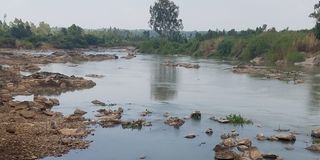Prolonged drought leaves poor residents of Siaya, Homa Bay on edge

Picture of drying River Nzoia in Siaya County.Prolonged drought in many parts of the country has resulted into shortage of water.
At 4am, Mzee Philemon Oluoch from Ogando village in Lambwe valley, Mbita sub-county in Homa Bay, is ready to start the journey with his herd of cattle in search of pasture and water.
The prolonged drought has dried all the available grass that livestock can feed on, forcing the farmers to search for it.
On the way, Mzee Oluoch meets other farmers and together, they trek towards the shores of Lake Victoria, where some grass is still available.
The conversations among them make the long trek bearable.
At daybreak, when they approach the lake at Gingo in Suba South, their exhaustion and thirst are quenched by the sight of the clear waters of the lake.
Besides livestock, people are also forced to withstand long queues to get the scarce resource.
“This has been the routine. Waking up early and coming back late; it is the only way we can save our animals. All the springs and the streams that we depended on have since dried up, leaving nothing for our animals,” lamented Mr Oluoch.
Lambwe Valley, being a semi-arid area, the locals depend on rain-fed agriculture.
“After our farms failed last season, we only have our animals to depend on. Some days back, we depended on River Lambwe, which has since dried up,” he said.
While walking with the livestock, Mzee Oluoch and others must be wary of marauding hyenas that occasionally escape from the Ruma Game reserve.
“Hyenas and other wild animals sometimes escape from the reserve, putting us and our animals in danger. Recently, there was an incident where farmers lost sheep in the neighbouring Ndhiwa sub-county,” he said.
The journey on the long, dusty road to the lake takes four or five hours.
The same scenario is witnessed in Uyoma, Rarieda sub-county in Siaya where people spend hours on end in queues to get water.
Dry wells
Ms Veronica Awuor, a mother of four, told Nation that the few available water points dried up a long time ago, forcing the majority of them to buy water from vendors.
“There are a number of people who have sunk individual boreholes and they sell it to locals. For a 20-litre jerrican, we pay Sh5 and when you buy from the vendors it costs Sh20. On average, we spend Sh100 daily on water, which is very high considering that the majority are living below the poverty line,” she lamented.
Those who cannot pay for the essential commodity are forced to camp until late hours to have water from the few government distribution points.
Some of the water pumps established by the government are poorly maintained and others have been vandalised.
The prolonged drought has also affected the price of vegetables, which the majority of the locals consume.
“Everybody is complaining. In the market currently, a single leaf of sukuma wiki (kale) costs Sh2 and it is very scarce. The few farmers who are cultivating along the lake shores are overwhelmed by the huge demand.
Mr John Owino, a resident of North Uyoma location, told the Nation that the community will prioritise having a permanent water solution when they get a chance to have public participation organised by the county government.
“We have suffered for many years ... If possible, we should have boreholes in every village. The community is suffering,” said Mr Owino.
According to a report from the Kenya Meteorological Department, the sunny period and high temperatures will continue in many parts of the country for the better part of February and into early March.
[email protected]





